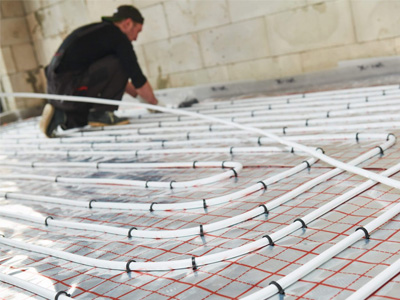Underfloor heating systems provide plenty of benefits for both homes and offices. It’s incredibly comfortable to walk bare foot on and frees up space since radiators are no longer around taking up wall space. Thanks to improvements in heating technology, underfloor heating is also cost-efficient, it has become a great solution for homes with renewable heating sources and can make your transition to a sustainable home that much easier.
Low Maintenance Costs
Being a touch material, polypropylene requires very little maintenance, this happens to be the case for both electric and water based underfloor heating systems, meaning whichever type of system you have installed you can be ensured its built to last.
Energy Efficiency
It’s been shown that underfloor heating is far more energy efficient than conventional radiators. Due to its heigh efficiency, energy bills can be vastly reduced. Homeowners should have an efficiency test performed to assess the effectiveness of their homes insulation to ensure optimal heating performance.
When underfloor heating systems are turned off, your room will retain heat better than traditional radiators as they start to cool down rapidly after being cut of from a heat supply. Underfloor systems retain heat for longer periods of time.
![]()
Low Running Costs
Contrary to popular opinion, running a whole-house underfloor heating system is cheaper than conventional radiators and central heating systems. This is due to the cost of rising gas prices, making refuelling a costly venture.
Meanwhile the running costs of underfloor heating systems can depend on a variety of factors including the effectiveness of the rooms insulation and the total running time. Thicker insulations yield much better energy savings. Water-based heating systems rely on gas and tend to have higher efficiency and lower costs but the initial installation is ocst-prohibitive.
Electrical-based systems are easy to install but do have slightly higher running costs than water based systems.
More comfortable
Homes with underfloor heating systems are noticeably more comfortable. This is due to the warm feeling one gets when their bare feet are in direct contact with the floor. Another reason is attributed to a consistent temperature profile around the room.
All parts of the room, so long as they share the same heating system, will maintain a balanced climate. One corner of the room won’t feel cooler than the other, which seems to be the case with radiator systems since they rely more on convection.
![]()
Better Hygiene
Underfloor heating systems are much safer and more hygienic than radiators. This is due to the high levels of moisture and humidity at floor level, creating the ideal breeding ground for creepy crawlies and dust mites. Switching to an underfloor heating system drastically improves hygiene all around, almost completely eliminating dust mites.
These tiny creatures can pose a life-threatening danger to individuals suffering from respiratory illnesses such as asthma.
Also, since you’ve removed the radiator from your room, this usually means one less surface that attracts grease and fathers dust. This also results in less air movement, which means less dust is transported around, making underfloor the perfect solution for people with allergies.
Controllable Temperatures
If the entire house has underfloor heating systems installed, residents won’t have to put up with the same temperature. With the use of a dedicated thermostat, they can change their room’s temperature based on their own preferences. Most radiators that are fitted with thermostatic valves for the same purpose are often unreliable with poor temperature control.
Of course, this requires homeowners to install a good UFH control system, which can be an extra cost, but it saves money over time since it keeps the settings low (or even off) in rooms that are not currently in use.
Compatible with Most Floor Surfaces
Underfloor heating systems are compatible with the majority of floor systems. You don’t need solid surface flooring such as stone or tile for best results. It is fairly common for homeowners with vinyl, carpet, laminated, and engineered wood to lay out polypipe heating solutions. Of course, rooms with solid floors will retain heat for longer than carpets, but that isn’t really a problem.
Creates Additional Space
Homeowners who have used radiators will complain about their precious real estate being lost due to a large amount of space lost to these bulky devices. But with underfloor heating systems, there is no need for radiators. All of a sudden, a large amount of space is cleared up for extra storage, sofa, kitchen units, or even a doorway.
UFH Suits Your Preferences
Whether you sport minimal Scandinavian decor or like something more traditional, underfloor heating systems will accommodate any style since they’re tucked out of sight, but not out of mind! In contrast, radiators are awkwardly taking up space in your room and can derail your decor settings. Picture straight clean lines with artful galleries and aesthetic floor-to-ceiling curtains… and then an unsightly radiator takes away from the overall aesthetics.
But it gets worse. Radiators can pose a serious health and safety risk, especially to small children and vulnerable adults due to their jaggy corners and the potential of fire hazards. These are the ideal conditions for accidents to happen without any warning.



